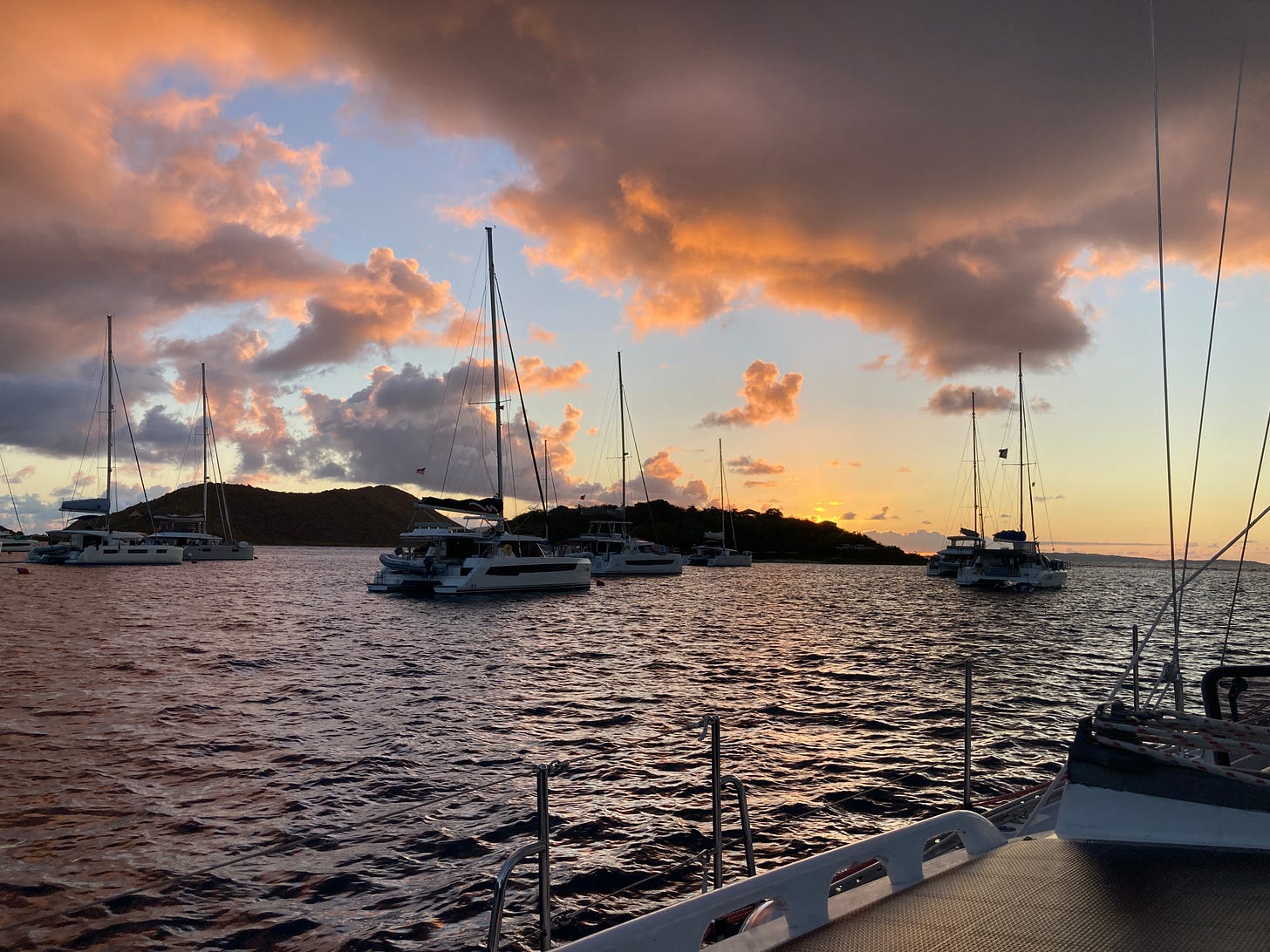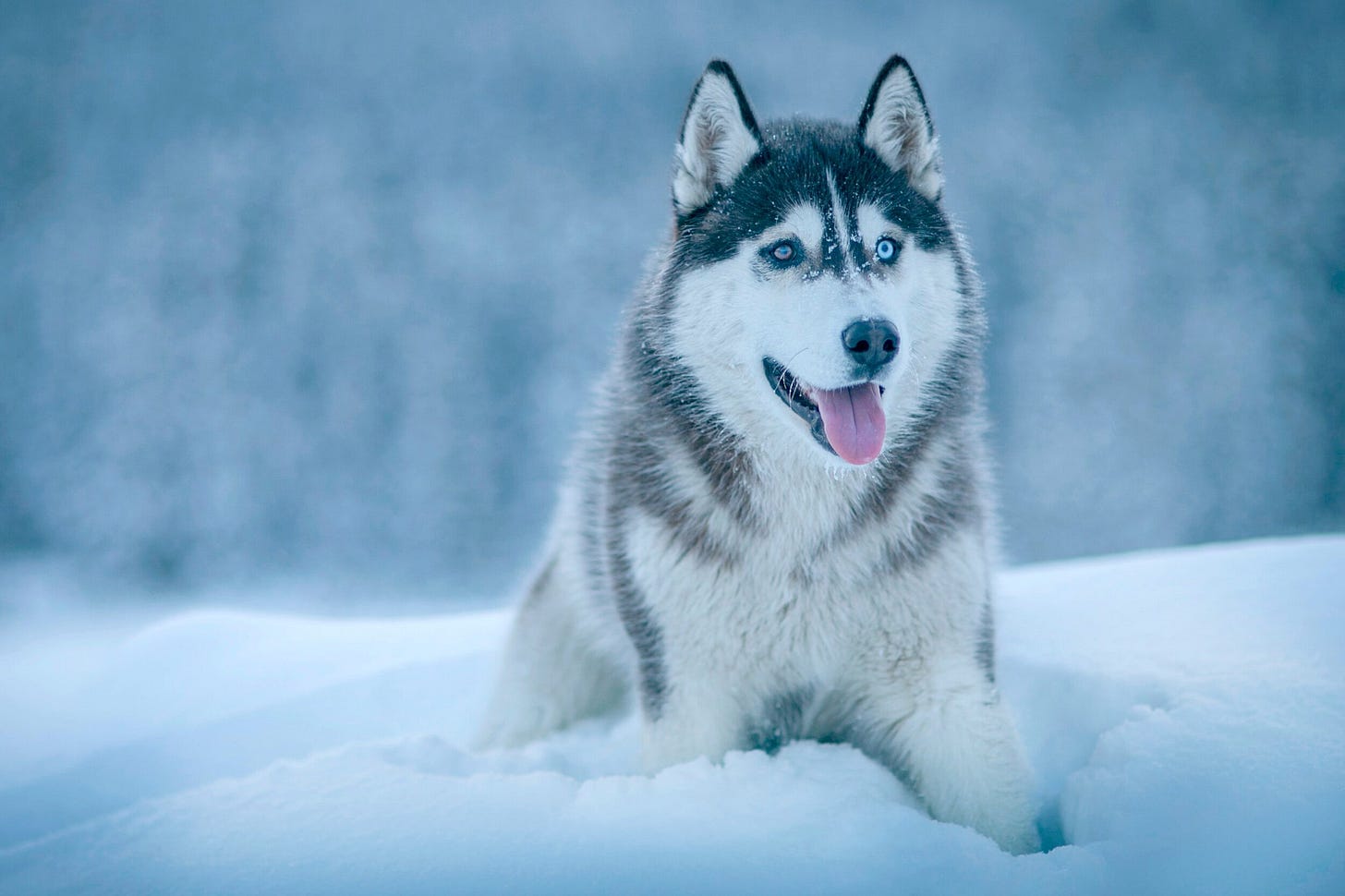Well, Laughing Gull, a 1996 monohull with classic lines, has truly crossed into the land of the floating porch. We hopped over to the British Virgin Islands last Sunday, and it is a shockingly different world to the sleepier vibe of St. John. I first started coming to the BVI in the 1970s, when it was a relatively uninvaded paradise. It got busier over the years, of course, but I haven’t been back here since 2010. So I was ready for a cruising area that is cranked up to 11. And it is delivering that, and may even be cranked up to 12. Intensely busy, with almost every anchorage full of twin-hulled, hard-partying, charter parties. Mooring balls packed tight into most of the popular spots, and every one taken by evening. Restaurants and beach bars everywhere. Superyachts swanning about. The BVI has long been the charter sailboat capital of the world, and I am not surprised to see that it retains its crown.
As it should. Everywhere, people are enjoying the hell out of their charter weeks. And the one thing I care most about, the one thing that most supports the crown, is as it was 50 years ago: and that is the sailing, which is spectacular. Breeze, lots of sun sparkling across waters that are every shade of blue, and beautiful beaches, bays, and islands everywhere. This week we are in a stretch of weather where a parade of frontal systems coming off the US mainland is moderating the trade winds a notch. And delivering rain-free overnights, which is a blessing to good sleep. Going upwind in LG in 13-15 knots, tacking close off beaches and verdant shorelines, is pure pleasure.
The charter industry has thoroughly appropriated the waters of the BVI in the same way the lobster industry has appropriated the waters of Maine. A little restraint from the appropriators, both north and south, would probably be a very good thing. But no matter how much the charter industry overpacks the harbors and anchorages with a neverending swarm of boats that trail a cloud of tourist dollars everywhere they go, the sailing will always be special.
Nestling into the anchorages with all those boats is an eye-opener. The ratio of catamarans to monohulls is more extreme here than even the Bahamas. Almost everyone seems to be on a cat: lounging up forward on bean bags, socializing heartily on the back porch, or floating about on pool noodles with rum drink in hand. Overnight, the anchorage rumbles with the sound of generators cranking frigid AC. To be on a monohull, with open hatches, in this twin-hulled crowd is to be an oddball. At least the sailing is so good I have seen some BVI charter cats actually sailing upwind, a rare sight in my experience (most cats seem to prefer to burn fossil fuels when going to weather).
The reserveable “Boatyball” mooring system is also a plus, apart from the fairly steep cost ($55 a night). This is the first time I have encountered it, and securing a mooring requires going onto the Boatyball website at 7 am and quickly clicking on your desired mooring ball before they are all snapped up by the charter crowd. It is almost funny to hover over the keyboard, the sun barely up and your coffee steaming nearby, waiting for the new reservations to open. It’s like trying to secure concert tickets to a very popular artist. So far, it has worked, and knowing you will have a place to moor when you arrive is worth some price for sure. Gone are the bad old days of boats racing each other into anchorages and fighting over moorings (a la Ile Des Saintes).
It’s not clear where all the Boatyball mooring revenue goes, beyond maintaining the moorings themselves. But the moorings alone are a benefit to the local environment. Before crossing to the BVI, LG was anchored in Coral Bay St. John. I like an anchorage on the eastern side of Coral Bay, near Pelican Rock, which has a nice beach and some okay snorkeling. But the bottom there is more old, dead coral than sand and it can be tricky to set your anchor (you can see where the name Coral Bay came from). When I dove the anchor to re-assure myself I wouldn’t float away in the night I could see my chain sweeping across the bottom, upending pieces of old coral and sawing across any outcroppings. It was a stark visual lesson in what anchors and chain can do to live coral and seagrass meadows, akin to the way trawling nets strip-mine the sea bottom. Mooring fields help stop the destruction of whatever might be living below and also set a limit on the number of boats that can pack into a small space. For that, I am willing to pay a price.
LG is currently anchored in sand (love sand) in North Sound, Virgin Gorda, in Drake’s Anchorage (he did come here). It is my kind of anchorage. Surrounded by reefs, which knock the swell down, and open to the breeze. Currently there is only one other boat with us, which is a kind of solitude that is not easy to find in these parts. A perfect spot to make water and do laundry. The dozens and dozens of charter boats that are also in North Sound at the moment prefer the mooring fields near the bars and resorts. We’ll get there soon enough. But for now, after a blissful sail from Marina Cay, along the north shore of Virgin Gorda, we can pretend—briefly—that we are not living in a charter cat world.
Anthropocene Notes:
Iditerod Indictment: A scathing takedown of the race and its cruelty. I’ve long felt the Iditerod is America’s equivalent of bullfighting. It should end:
The Iditarod persists in the idea that we all could use a little more rugged American origin-story scruff, that we have become too bespoke-suited and monogrammed-slippered. But actually, the race was launched in 1973, and it has all the ethic of a refrigerator magnet, and it really would be more instructive and character-revealing if we actually tied the mushers together in gang-lines and ordered them to find the trail in a chinook, noses down and hind ends up. First off, it would make them harden up, because of the 603 dogs that started last year’s race, just 293 finished, and three died, and not because they were fainthearted. Here’s a tip: One of the things that happens to a warm-blooded vertebrate, whether dog or man, when it tries to haul a load at pace in the cold extremes is that it pukes. The leading cause of death of Iditarod dogs is aspiration in their own vomit.
Climate-maxxing? Um, okay. If shrinking humanity’s climate footprint can be turned into an aspirational competition, then I am all in favor.
There’s now an easy way to turn any aspect of life into something to optimize — just add “-maxxing.” Gymmaxxing is about getting ripped. Moneymaxxing means accumulating wealth as fast as possible. Over the past couple of years, this social media-driven wellness fad has spread to more and more activities: Tanning is sunmaxxing; drinking plenty of water is watermaxxing. Even at night, the grind for self-improvement continues, with sleepmaxxing hacks designed to help you achieve peak rest…
Think of it this way: Climatemaxxing would be an optimization challenge, finding the biggest ways to tackle climate change at home, at work, and in your community. Sure, you could #climatemaxx your commute by biking, but achieving maxximum impact might mean joining a committee to make your town more bike-friendly for everyone. And if all you have energy to do is eat a can of beans, a climate-friendly source of protein, for dinner, hey, what once might have been considered a boring meal is now an effort to self-improve by climatemaxxing your diet. Forget about your carbon footprint — climatemaxxing frames action as an aspiration, not a sacrifice, as well as an antidote to despair.
I actually love the concept of expanding efforts to address climate beyond the personal, since it is politics and broad culture-change that in the end will determine the fate of the planet. If slapping a slightly-awkward double-X label on it helps, then I am eXXcited.
Helpful visualization of the need for climatemaxxing (click on image):
If you liked this post from Sailing Into The Anthropocene, why not subscribe here (free!), and/or hit that share button below? You can also find me on Instagram and BlueSky.









Thankfully, yes. Though we did stop in and take a look at Foxy's. No drunkeness thouggh.
Hope you've been able to avoid the Soggy Dollar on Jost Van Dyke. Bourbon Street transposed to a Caribbean Island. Rarely can you see so many people so drunk.